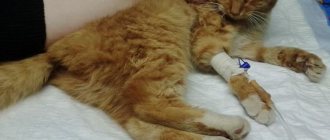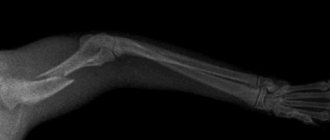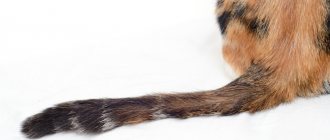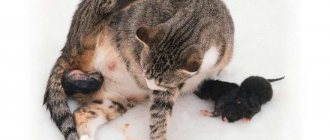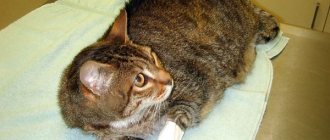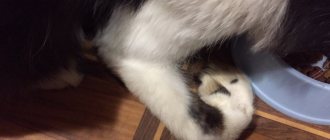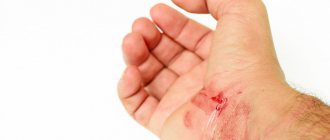Violation of the integrity of bone structures in small pets is a common case when owners turn to a veterinary surgeon. The pelvic joint area is often injured due to a variety of reasons.
Depending on the complexity of the fracture, veterinary medicine offers conservative and surgical treatment methods. The pet’s recovery is influenced not only by the surgeon’s qualifications, but also by postoperative care, as well as timely first aid.
Causes of pelvic fracture
In veterinary practice, we most often encounter the following causes that lead to fractures of the pelvic bones in domestic cats:
- Pet falling from height . Despite the fact that cats have gained fame as steeplejacks, walks along tall trees and rooftops are not always successful.
Every third case of visiting a veterinary clinic is due to an animal falling from a tree, balcony, or roof of a house.
- Collision with a vehicle. A collision with an animal by a car or bicycle usually leads to combined injuries. A pelvic fracture in a cat during road traffic accidents occupies one of the leading places in the list of causes leading to the disease.
- Various blows and injuries during fights with rivals and enemies (dogs) can lead to a fracture of the pelvic bones in a cat.
- The cause of the surgical problem may be a medical condition. In this case we are talking about pathological fractures. The disease develops when there is a metabolic disorder, accompanied by a decrease in the strength of bone tissue.
Serious damage to the pelvic joint can also be caused by domestic trauma, careless handling of the pet, for example, when it is pinched by doors, or when heavy objects fall on the animal.
We recommend reading about a spinal fracture in a cat. You will learn about the causes and types of spinal fractures, symptoms, diagnosis and treatment. And here is more information about the treatment of dislocation in a cat.
Classification of injuries
Veterinarians conditionally divide fractures in domestic cats in the pelvic area into two large groups. The first category includes fractures that occur with separation of the pelvic bones. The second group consists of fractures that occur without separation of the bone structures of the pelvic girdle.
In veterinary practice, the first group of fractures includes fractures of the pubic, ischial, ilium, sacroiliac joint, as well as fractures of the body and inner wing of the ilium.
Anatomy of the pelvis and hip joint
Injuries that occur without separation of the bone formations of the pelvic girdle include the following types of fractures: fracture of the internal and external tubercle of the ilium, ischial tuberosity and fracture of the acetabulum.
Veterinary surgeons most often deal with mixed fractures of the bone structures of the pelvic region, when an animal has a combination of various injuries. According to symmetry, fractures can be unilateral or bilateral. Based on the degree of damage, veterinarians distinguish between cracks, fractures and complete fractures of the pelvic bones.
Symptoms of a bone fracture
A surgical disease in the form of a violation of the integrity of bone structures is characterized primarily by pain. A sick animal exhibits the following clinical signs:
- Impaired support function. With a unilateral fracture, the cat does not step on one of the hind limbs and holds it suspended. Fracture of the pubic bones is characterized by mixed lameness or lameness of the supporting limb. If the integrity of the ischium is violated, a sick animal experiences lameness of the hanging paw. With bilateral damage, the pet is unable to stand or walk. Motor function is completely absent.
- The animal is worried, screams, meows, can show aggression, and bite. This behavior indicates severe pain. The most pronounced pain syndrome is in the sacroiliac discrepancy due to damage to the nerve endings in the lumbosacral region of the spine.
- When examining a cat, asymmetry in the pelvic girdle is often noted. This phenomenon is especially often observed during maklok fractures. When the tuberosity of the ischium is fractured, a depression is visually observed in this place, which does not correspond to the anatomical structure. When the pubic bone is damaged, the hind paw is often abducted to the side.
- Active as well as passive movements of the limb in the pelvic area are accompanied by a crunching sound (crepitus) caused by fragments of damaged bone structures.
- Visually and when palpating the pelvic area, swelling and swelling are noted. Sometimes the swelling spreads to the anal area.
- The animal refuses food and water, does not lick itself or groom itself.
- There are difficulties with urination and bowel movements.
- Neurological damage is characterized by decreased sensitivity, paresis and paralysis of the hind limbs.
Injuries in the pelvic girdle are often accompanied by damage to the bladder, rupture of the rectum, injuries to the genital organs and other associated pathologies. In addition, a fracture of the pelvic bones can be open.
Diagnostic techniques
Laboratory tests (blood tests, for example) are usually not required, but other diagnostic methods are actively used:
- Full medical examination . It is very important to make sure that your pet is not showing symptoms of hypovolemic shock, indicating critical blood loss. It is equally important to find out if the pet has any other serious injuries that threaten its health or even life. It is highly advisable to perform a colonoscopy to find out whether the final segment of the rectum is pierced by sharp bone fragments.
- X-ray and ultrasound of the pelvic cavity . This is a mandatory and vital stage. It is necessary to find out exactly how many and what kind of bone fragments are left in the pelvic cavity, what parts the pelvic bone is divided into, whether the sacrum and acetabulum are damaged... It is also recommended to “pump” the rectum with a contrast solution so that during x-ray it can be clearly seen that it is not “leaking” or somewhere in the intestines, pierced by bone fragments.
Orthopedic examination and neurology
If the animal is unable to stand at all, a full orthopedic examination is required. In addition, it is the only method available in the field. With careful palpation, you can find out a lot of “interesting” things, but before that you need to administer strong sedatives to your pet. Otherwise, the pet may simply not survive the painful shock. So, damage to the pelvic bones is indicated by crepitus, that is, cracking, of bone fragments under the fingers.
In addition, a neurological examination is important. It is mandatory to perform it, since the surgical procedure depends on the condition of the limbs (and with such injuries it is extremely rare to do without it). The fact is that with fractures of the pelvic bones, the sciatic nerves passing through those areas are often damaged. If they are partially dissected, surgical intervention is greatly complicated.
First aid
If a fracture of bone structures is suspected, the animal must first be provided with complete rest. The injured cat must be moved to a flat surface. A wide board, a plastic panel from a car, thick cardboard or plywood are suitable for this purpose. If you don’t have such an object at hand, you can wrap the cat in a towel or blanket.
Transporting a cat with a pelvic fracture
To ensure immobilization, the pet should be secured to a hard surface using ropes or belts. In field conditions, a belt, harness, or cord are suitable. The cat must be secured on the board in the forearm area. An injured animal should be transported in the back seat of a car. It is important that damaged bones are kept at rest.
Despite the severe pain, veterinarians do not recommend giving your pet any painkillers. In the case of an open fracture, the owner must take measures to stop the bleeding, cover the wound with a clean cloth and transport the animal to a specialized facility as quickly as possible.
What can you do yourself to help your cat?
The main task of first aid for a fracture in a cat is to understand whether there is bleeding and stop it. As a rule, severe bleeding accompanies open fractures, fractures caused by bites and gunshot fractures. To stop bleeding, it is better to use a pressure bandage, which is effective in 90% of cases. We recommend a pack of sterile gauze pads to stop bleeding. If they are not nearby, then you can use a handkerchief, mitten, piece of fabric, or feminine pad. Sterility is not so important now, the main thing is to stop the bleeding, which is life-threatening for the cat. A swab made of napkins or other fabric should be placed directly over the source of bleeding and bandaged quite tightly - with gauze or an elastic bandage, or a piece of fabric. Now - hurry up to the veterinary clinic. Our doctors recommend not wasting time calling a doctor to your home in such a situation, because full care for a fracture can only be provided to a cat in a clinic setting.
If there is no bleeding, but you see that the cat most likely has a broken front or back leg and it is “dangling around a lot,” you can immobilize it in the position it is in. Don’t try to “set” the fracture yourself! This is very painful. If handled improperly, the sharp edges of the bone can damage blood vessels and nerves, causing pain and additional injury to the cat. You just need to ensure that the cat's paw remains motionless while transporting the animal to the clinic. If you are in doubt or afraid, it is better not to do anything and take your cat to a veterinary clinic as quickly as possible.
Diagnosis of a cat's condition
After collecting an anamnesis, the veterinarian will examine the injured cat and palpate the area of injury. If there are associated injuries, necessary assistance will be provided. After stabilization of the animal's condition, an x-ray examination will be prescribed. Diagnosis is carried out after preliminary sedation.
To establish the type, location, and severity of a fracture, lateral and ventrodorsal x-rays are used in veterinary practice. Examination of the animal in two mutually perpendicular projections allows one to obtain data on the proximal part of the femur, assess damage to the lumbar vertebrae, and also examine the caudal region of the abdominal cavity. In some cases, contrast X-ray diagnostics using iodine preparations is used.
Fracture of the pelvis in a kitten along the acetabulum and ilium
Modern veterinary clinics also have the ability to conduct a computed tomography scan of the pelvic area. The method allows you to obtain layer-by-layer photographs of all bone structures and internal organs, as well as assess their condition. In some cases, your veterinarian may order a magnetic resonance imaging scan.
The animal must undergo a neurological examination to identify damage to the sciatic nerve and nerve endings of the lumbosacral plexus.
In case of concomitant injuries, the furry patient undergoes a clinical blood and urine test and an ultrasound examination of the internal organs.
Fracture treatment
Restoring the motor function of damaged bone structures of the pelvic girdle is a long process. In veterinary practice, both non-surgical and surgical methods of treating fractures are used.
Without surgery
The vast majority of pelvic fractures in domestic cats are treatable.
non-surgical treatment methods. First of all, the sick animal is anesthetized using local anesthesia.
If necessary, a veterinary surgeon will perform a procedure to reposition the bone structures to their anatomical location. Using an immobilizing bandage, the specialist will fix nearby joints.
Conservative therapy is most effective for fractures of the pubic and ischial bones, as well as the iliac wing. In this case, it is best to place the animal in a cage that limits movement. Recovery usually occurs within 3 to 4 weeks.
In order to prevent the inflammatory process, a sick pet is prescribed a course of drugs from the group of corticosteroids: Prednisolone, Dexamethasone, Methylprednisolone. The dose and duration of use are prescribed only by a veterinarian.
According to indications, painkillers may be prescribed to an injured animal. For severe pain in the first hours after injury, analgesics such as fentanyl and tramadol are used. Subsequently, Ketonal, Spazgan, Pentalgin, Baralgin, Meloxicam are prescribed to alleviate the condition.
In addition to drugs that have a pronounced analgesic effect, sedatives are also used in conservative treatment: Fitex, Xylazin, Fospasim.
The operation and features of its implementation
If an animal has a complex fracture and there are fragments of bone structures, a veterinary surgeon comes to the rescue. Osteosynthesis is used in the surgical treatment of damage to the acetabulum, the development of stenosis of the pelvic canal, as well as concomitant injuries associated with damage to the organs of the genitourinary system, rectum, etc.
The bone fragments are fixed during surgery using a rounded plate, screws or steel pins with tying wires. In severe cases, arthroplasty of the damaged hip joint, as well as endoprosthetics, is performed.
Fracture of the acetabulum in a cat with subsequent fixation using a plate and screws (an osteotomy of the greater trochanter of the femur was performed for access)
As a rule, surgeons recommend surgical treatment of a pelvic fracture based on a fresh injury. This approach eliminates the risk of improper fusion of bone structures and the development of neuromuscular damage to internal organs.
An operation several months after an injury or to correct pathological bone fusion with a conservative method of treatment is traumatic and complex. The surgeon has to resort to resection of the ventral part of the pelvic bone or a complex symphyseal osteotomy.
Animals are subjected to surgical treatment with the use of tension elements when a dislocation of the sacroiliac joint is detected, if the injury is characterized by severe and prolonged pain.
What operations are there?
Osteosynthesis is performed using metal structures with which parts of the bone are fixed to each other. Metal parts can be placed inside the bone (pins, wires), pass through the bone (screws, screws, wire sutures) or attached to its surface (plates). In addition, there are methods for fixing fractures in which the wires pass through the bone fragments, and the main structure that ensures the strength of their connection is located outside the limb (Ilizarov apparatus and other external fixators).
Osteosynthesis is performed under general anesthesia. The doctor selects a fixation structure depending on the type of fracture and accompanying soft tissue injuries. In veterinary medicine, we specialize in complex fractures (comminuted, crushed, multifocal, gunshot). We have all the necessary equipment and experience to treat them, including using external fixators and the Ilizarov apparatus. Many cats, who in other clinics were offered amputation of their paws due to complex fractures, retained their limbs thanks to the joint efforts of our doctors and their owners.
How to care for a cat with a fracture
A complete and speedy recovery is only possible with proper care for an injured pet. First of all, the owner should take care of limiting the cat’s physical activity. For this purpose, cellular content can be used in the first week of conservative treatment or the postoperative period.
With injuries to the pelvic girdle, the animal may develop problems with urination and bowel movements. The owner should closely monitor the cat's excretory functions and, if necessary, provide assistance.
To prevent constipation, it is recommended to feed your pet wet food, excluding dry mixtures. On the recommendation of a veterinarian, you can use Vaseline oil or Duphalac in the absence of stool. It is not always possible to fully massage the abdominal area due to pain.
It is important to prevent the animal from jumping and causing repeated injury. Under no circumstances should the cat be allowed outside until it has fully recovered. The pet should be fed with special food recommended by a veterinarian. If necessary, a course of vitamin and mineral preparations is prescribed.
During the rehabilitation period, the pet must undergo a control x-ray examination to determine the correct fusion of the bones. The date of its implementation will be determined by the attending veterinarian.
Advantages of performing osteosynthesis in cats in our veterinary clinic
Our veterinary clinic performs osteosynthesis for cats in Moscow at an affordable cost. In addition to reasonable prices for operations and medications, the advantages of the clinic include:
- High professionalism of veterinary specialists. Our specialists quickly and accurately diagnose fractures, select the optimal scheme for fixing bone fragments (wires, plates, external fixation devices) and perform surgical procedures with minimal discomfort for the animal.
- Modern operating room equipment. We have everything necessary to perform surgical interventions of various levels, from simple manipulations to complex operations for the treatment of multiple fractures.
- Animal care. All preparatory and postoperative procedures will be carried out in the hospital. In addition, owners will be provided with advice on caring for the cat for its fastest possible rehabilitation.
Osteosynthesis, performed according to all the rules and taking into account the specifics of the injury, ensures rapid restoration of the cat’s mobility and the absence of complications during recovery. So a fracture is, of course, an unpleasant problem, but with a professional approach it can be solved.
Consequences that may arise
One of the common complications of pelvic bone fracture is improper healing of damaged structures. In this regard, the animal may experience lameness, impaired motor activity, and changes in gait.
With concomitant injuries and complex fractures in domestic cats, pelvic canal stenosis is often observed. The complication develops over time, represents a narrowing of the pelvic ring and is accompanied by difficulties with bowel movements and chronic constipation.
In case of damage to the nerve endings, the cat often experiences loss of sensation in the hind limbs, back and tail.
We recommend reading about a cat's tail fracture. You will learn about the causes of injury, signs and symptoms, diagnosis, and treatment options. And here is more information about what to do if a cat is lame on its paw.
Prevention of fractures
The owner can prevent injuries to the animal by following the advice of veterinarians:
- Limit your pet's access outside the apartment. The street is a dangerous place for a furry couch potato.
- The balcony must be kept closed and inaccessible to an inquisitive animal.
- Windows must be equipped with bars.
- Spay and neuter pets.
- Feed your pet high-quality balanced food.
A pelvic fracture in cats is a serious injury to bone structures, often associated with pathology of other organs. It is important for the owner to immobilize the animal at the first sign of injury and transport it to a veterinary clinic as quickly as possible. After an X-ray examination, the surgeon will decide on the method of treating the fracture.
During therapy and in the postoperative period, the owner will need patience, love and compliance with the recommendations of a veterinary specialist.
general information
The name “pelvis” is not accidental. The bones of this part of the skeleton support internal organs, including parts of the reproductive, excretory, and digestive systems. It is not difficult to guess why a pelvic fracture is so dangerous. Any damage to these bones is fraught with injuries to internal organs. This includes death from massive internal bleeding, and death from fecal peritonitis, and you shouldn’t forget about death due to painful shock... Simply put, the injury is extremely bad. Especially in a kitten, whose body is not nearly as strong as that of adult cats.
Note that in young animals, it is not a fracture that is more common, but rather a rupture of the ligaments of the pelvic cavity and damage to its cartilaginous structures. Bones in this part of the body break more often in mature and old cats. The danger of “pelvic” fractures is also that, due to the shape of the pelvis, its bones break along several lines at once, which greatly complicates the diagnosis and subsequent treatment of the injured cat.
Most often, young pets are brought to clinics during the “March” period, since it is at this time that cats begin their mating season with all the ensuing consequences. In the morning and evening, in conditions of poor visibility, they constantly fall under the wheels of moving vehicles.
Useful video
For information about fractures in cats, watch this video:
Similar articles
- What to do if your cat is constipated?
Why do cats get constipated and how to treat it? Digestive problems in pets are one of... Painful bowel movements due to fractures of the pelvic bones, hind limbs, arthritis or pathologies of the anal glands. Read more - Spinal fracture in cats and cats: symptoms...
Unfortunately, a fractured spine in a cat is not uncommon. Only knowledge of symptoms, such as urination and incontinence, and proper first aid can save a cat's life. Read more
- Dislocation of a cat's hip joint, anterior or...
...load on the round ligament, and is accompanied by the exit of the femoral head from the anatomical (acetabular) cavity of the pelvis. ... Glaucoma in cats: symptoms, primary and secondary... Tail fracture in cats and cats: symptoms and treatment. Read more
- Tail fracture in cats and cats: symptoms and treatment
Tail injury or fracture in a cat: symptoms, owner actions and prevention. The tail of a furry pet is not just a decoration, but an important part of the body that performs certain functions. Read more
- The cat is limping on a paw (back or front), the paw is swollen...
Tail fracture in cats and cats: symptoms and treatment. How to trim a cat's claws: how to trim correctly... A cat has bitten you, your hand is swollen and red - what to do if this... Read more
How is the postoperative period going?
As a rule, after osteosynthesis, the cat remains in the hospital for 6 hours to 24 hours under the supervision of doctors. Then, suture treatment and painkillers are usually prescribed for 3-5 days. We recommend restricting movement for 4-6 weeks (cats can be placed in a large cage). The cat usually begins to lean on its paw 3-5 days after surgery.
After 3-4 weeks, you will need to visit the veterinary clinic with your cat again to take a control x-ray to assess the speed of fusion. On average, the rate of fusion, depending on the complexity of the fracture, varies from 2 to 8 months. After fusion, with the exception of rare cases (intra-articular fractures, fractures of the pelvic bones, very complex fractures in which the fixing elements firmly grow into the general mass of callus), metal structures are removed.

